The following address was delivered by Dr. Hyun Jin P. Moon at the 2018 International Forum on One Korea held at the Carnegie Institution for Science in Washington DC on December 12, 2018.
Distinguished guests, ladies and gentlemen:
It’s an honor to address this significant gathering at such a critical juncture in the turbulent history of Korea. Thank you for your concern about the future of the Korean peninsula and its impact on the Northeast Asia region and indeed on the entire world.
I wish to thank my good friend Dr. Edwin Feulner, founder of The Heritage Foundation, a leading scholar and friend of Korea. I also greatly appreciate Ambassador John Everard, former British Ambassador to DPRK, and noted Mongolian expert Dr. Alicia Campi for joining us today.
We also would like to warmly welcome from the Republic of Korea a visiting delegation with Action for Korea United, including former Korean Ambassador to Uruguay Jaebum Kim, Executive Vice-Chair of the Korean-American Association.
At this time last year, the Global Peace Foundation (GPF), Action for Korea United (AKU and our partners sponsored a related International Forum on One Korea in Seoul under very different circumstances than today. In 2017, many in Korea were in denial that a hot war could be a real possibility. Most on the peninsula were accustomed to the vicious cycle of “threat-crisis-talks-concessions” that Pyongyang employed so effectively in the past. Yet this time it was different.
The Trump Administration made Korea the top international priority for the US, taking strong leadership and reshaping the geopolitics of the region. It imposed biting sanctions and galvanized global support to enforce those sanctions, even getting China and Russia to follow suit. That was a break, for the first time and however briefly, from the Cold War framework which has dominated Korean peninsula dynamics. At the same time, sanctions were backed up by a credible U.S. military threat to the North, underscored by the example of U.S. airstrikes in Syria.
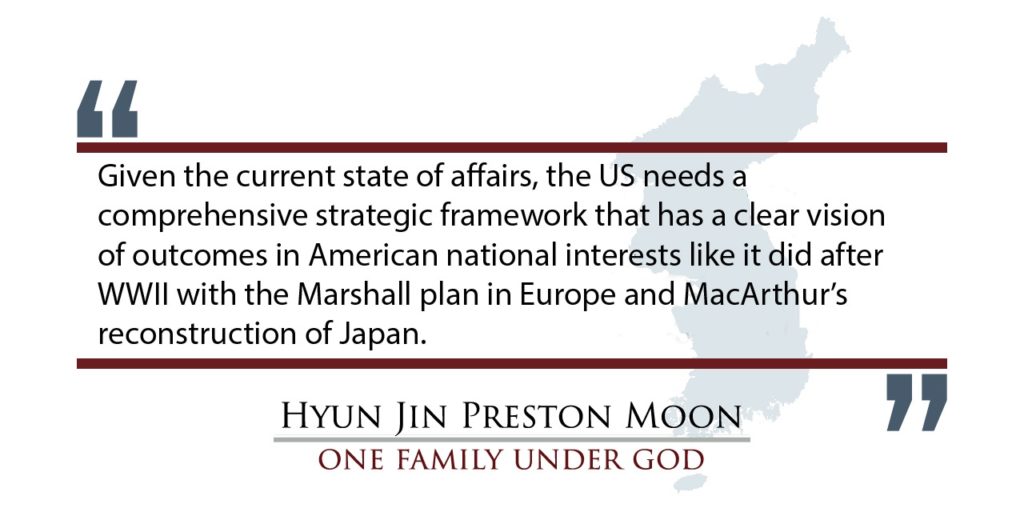
This aggressive American response with the full support of the international community, especially the North’s former allies, forced the hand of Kim Jong-un. This was possible since he had alienated his most important ally, China, by purging pro-Chinese factions in the North, like his uncle Jang Song-thaek. Furthermore, unlike his grandfather and father, he held a recalcitrant and, often, aloof diplomatic posture towards his former allies. Finally, his nuclear ambition to build a delivery system that could threaten the United States, Japan and all his neighbors in the Pacific Rim region, including China and Russia, became the catalyst for former geo-political rivals to come together to contain Kim.
In a relatively short period of time, Kim Jong-un’s lack of geo-political experience created a perfect storm of global condemnation on a par with the United Nation’s response to the outbreak of the Korean War. Yet, this time, unlike 1950, the North stood completely alone. This stark reality forced Kim to seek reprieve through his southern neighbor’s desire to deescalate the possibility of a hot war on the peninsula.
The newly formed Moon Jae-in administration was more than eager to comply. Representing the legacy of Kim Dae-jung and Roh Moo-hyun, it was natural that Moon would see the North’s overture as an opportunity to pursue a “Sunshine Policy” 2.0. This would build his and the Left’s political capital domestically as well as give him international bona fides as a peace broker.
What followed was North Korea’s participation in the Pyeongchang Winter Olympics and three highly publicized Inter-Korea summit meetings between Moon Jae-in and Kim Jong Un. Understandably, the world reacted positively to these developments since war had seemed imminent. It appeared that the South Korean president’s initiative to “engage” the North was easing the tensions on the peninsula.
Yet, the larger issue of global sanctions led by the United States, as well as its military option to take out the North’s nuclear capabilities, remained a real threat to Kim Jong-un. He found a willing partner, yet again, in Moon Jae-in who took extraordinary steps to advocate direct bilateral talks between the United States and the DPRK, breaking with longstanding diplomatic practice. By early spring, an urgent message from Kim prompted a sudden meeting between South Korea’s Foreign Ministry and the White House that set the stage for the Singapore Summit, the first ever face-to-face meeting between the leaders of the US and the North.
Both Kim Jong-un’s grandfather and father dreamed of having bilateral talks with the United States since that would give the North international legitimacy, especially after the fall of the Soviet Empire. This summit would give Kim what his predecessors could not accomplish and, thereby, increase his stature at home and abroad as an equal to the American president. Once he stood utterly alone, yet with the help of the South Korean president, he was now poised to meet with the very man who isolated and nearly brought him and his regime to the brink. The Singapore Summit was to be his great comeback.
The Singapore Summit exposed the flaws in American policy that has overwhelmingly relied upon the naive assumption that the US could narrowly negotiate North Korea’s “complete, verifiable and irreversible denuclearization” (CVID). In return for dismantling its nuclear program, the United States was prepared to aid the North’s flagging economy and even ensure the protection and survivability of the Kim regime. In so doing, the US was willing to forfeit its basic values by ignoring the North’s atrocious human rights record as well as solidifying a two-state reality on the peninsula.
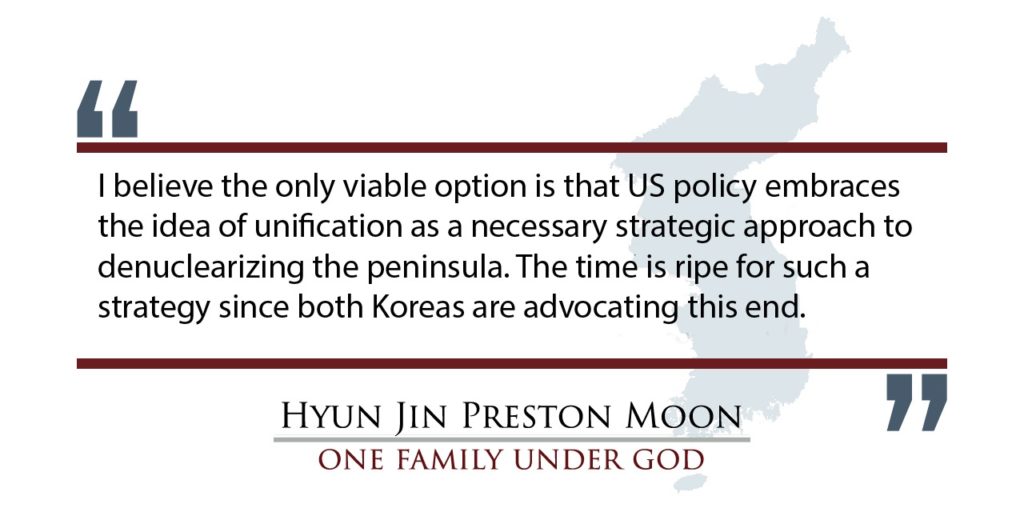
Although the North agreed to these terms, most Koreans believed that Kim Jong-un had no intention of honoring this agreement. The US failed to see that the North’s nuclear program is more than its insurance policy against Western aggression; it is Kim’s crowning achievement in the face of a hostile world. It is a source of personal and national pride as well as evidence of his intrepid independence from foreign influence. For Koreans, whose fate had been determined by foreign powers throughout the 20th century, the need for independent self-realization is a powerful force and, therefore, admired when exhibited, even by Kim.
Nevertheless, shortly after the summit, the North made several concessions such as: closing an obsolete nuclear test site; the release of imprisoned Americans; the return of American service member’s remains; and the cessation of missile tests and other acts of provocation.
These concessions were largely hailed in the West as great achievements in US relations with the North. The Trump administration saw them as the “good will” developed by the president and Kim and continued to believe that negotiations would lead to denuclearization. They assured the public that sanctions were still effective and there was no reason to ease them unless the North complied with their agreement.
Unfortunately, the sanctions regime that initially brought Kim Jong-un to heel had already begun to unravel. Before the US-DRPK summit, Xi Jing Ping, the premiere of China, invited Kim to meet in Beijing with full state honors. It was the first meeting between the two leaders since Kim took power in North Korea, and other meetings followed. Ironically, the Singapore Summit was the catalyst for mending grievances between China and North Korea.
In addition, shortly after the US-DPRK bi-lateral talks, the Russian Foreign Minister made a trip to Pyongyang to meet personally with Kim Jong-un, further eroding the sanctions regime. Subsequently there was clear evidence that both China and Russia had violated their agreement to impose sanctions on North Korea. Unfortunately, the geo-political reshuffling that had isolated Kim by early 2018 was undone by US acceptance of bi-lateral talks with the North, since both China and Russia naturally perceived it as a threat to their own national interests on the peninsula.
The Moon Jae-in administration looked at all these developments positively since it was largely due to its efforts that Trump met with Kim and, in its view, avoided a potential hot war. Moon believed in engagement with the North like his ideological predecessors. The Singapore Summit gave him greater license to pursue that end.
What followed was an evolving policy of greater cooperation with the North. The Moon administration then focused on the “relaxation of sanctions” and the “declaration of the end to war” between the two Koreas and the United States to the chagrin of the US and Japan. On September 19, in his speech at Rungrado Stadium, Moon stated that he and Kim Jong-un pledged “to hasten a future of common prosperity and reunification on our own terms..” This statement was made under “the principle of autonomy for our people, whereby we ourselves determine our own fate,” meaning the two Koreas and no other.
Moon broadened the theme of North-South cooperation to advocate for global sanctions relief on behalf of North Korea. During the UN General Assembly on Sept 26th, he stated that “now is the time that the international community should give something in return for the new choice and efforts that North Korea has made.” On Oct 19th, in a gathering with heads of European nations, he called on them to relax sanctions on the North, even trying to set up meetings on behalf of Kim Jong-un with prominent leaders like Pope Francis.
To make matters even worse, satellite imagery has recently revealed that the North continues to develop its nuclear and missile programs in direct violation of the agreement signed in Singapore. This evidence reaffirmed what many Koreans and skeptics had already feared. The summit created an atmosphere of loosening sanctions and an unhealthy North-South cooperation that threatens the ROK-US-Japan alliance and its attempt to curtail the North’s nuclear ambition. Clearly, when one objectively assesses the events of this year, Kim Jong-un has turned a potential disaster into a personal triumph.
Under current circumstances, the United States and the international community should reassess their Korea policy. Clearly, the “bite” of global sanctions has waned since the Singapore Summit. Also in the minds of many the North Korean nuclear crisis has abated due to the “perceived” improved relations between the US and the DPRK. In this environment, can the US make a case for military intervention? It seems unlikely.
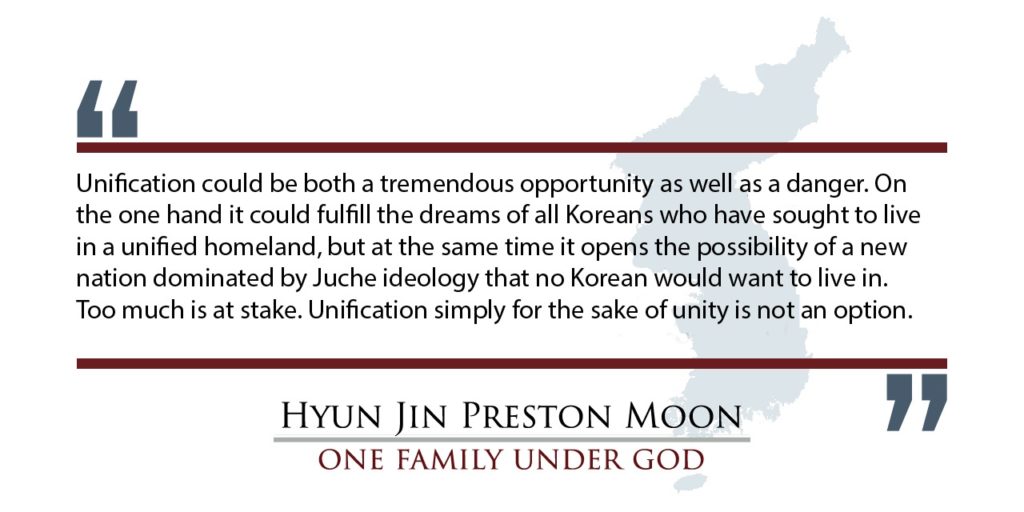
Then, what is the viability of the US negotiating position in relation to its narrowly defined goal of “complete, verifiable and irreversible denuclearization” in North Korea? With a weakened global sanctions regime and a diminished credible military threat, the probability of success is low. Yet, those in favor of bi-lateral negotiations continue to believe that it is still possible, although they acknowledge it will take some time. At some point, they should assess the failed record of talks with Pyongyang on denuclearization since the early 1990s to today, through three subsequent presidencies to the current Trump administration.
The fact remains that the longer the negotiations, the less likely the desired outcomes. The North is a generational dictatorship, and recognizes the ephemeral nature of democratic nations with presidential term limits and changing political tides. Over the years, it has learned how to manipulate its relationships with ROK and US to its benefit. Simply put, all it needs to do is drag out the talks to buy time and economic concessions, while hoping for a change in the domestic political fortune of its adversaries.
The US should recognize its inability to execute a narrowly defined endgame, especially when there is a moving goal line, due to wishful thinking and poor planning. This has been proven too often in its recent history. The failed or inconclusive military adventures in Vietnam, Iraq and, currently, in Afghanistan are evidence of this. At tremendous cost of life and treasure these conflicts were undertaken with limited objectives. US policy failed to recognize the larger consequences and how much America would need to invest in time and resources to achieve a viable outcome.
Given the current state of affairs, the US should abandon its narrow bi-lateral approach to denuclearization. It needs a comprehensive strategic framework that has a clear vision of outcomes in American national interests like it did after WWII with the Marshall plan in Europe and MacArthur’s reconstruction of Japan. It should set aside the hubris and faulty assumptions that narrowly defined goals can somehow be accomplished. History has proven that this will never happen. There are always unexpected consequences.
I believe the only viable option, at this point, is that US policy embraces the idea of unification as a necessary strategic approach to denuclearizing the peninsula. The time is ripe for such a strategy since both Koreas, after the North-South summit in September, are advocating this end. The lessons of the Singapore Summit should not be lost by a narrow bilateral US involvement in the future of the peninsula. As the world’s superpower, it should not give cause to its geo-political rivals, such as China and Russia, to interfere in what should be a matter for Korean self-determination.
However, that is not to say that American leadership is not needed in guiding and incentivizing the process of unification. Like the Marshall plan and Japan’s reconstruction, US aid and protection was critical for regional and national transformation to take place as the free expression of the people. This is the case since one needs to accept the fact that unification could be both a tremendous opportunity as well as a danger.
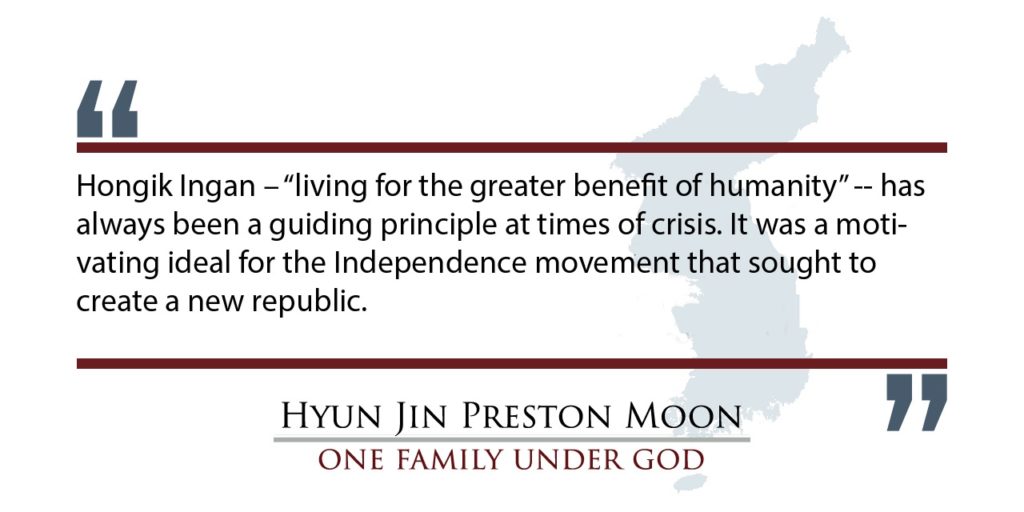
On the one hand it could fulfill the dreams of all Koreans who have sought to live in a unified homeland, but at the same time it opens the possibility of a new nation dominated by Juche ideology that no Korean would want to live in. Too much is at stake. Unification simply for the sake of unity is not an option.
I have long recognized the need for such an “out of the box” approach ever since my father pioneered the opening to North Korea through his groundbreaking meeting with Kim Il-sung in 1991. The approach that encapsulates these elements is summarized in my book “Korean Dream: Vision for a Unified Korea.” Up until the publishing of my book, all academic treatises on unification focused on the “process” of unification, leaving open the possibility of a wide range of outcomes. However, my approach starts with the goal of creating an ideal nation, separate from the legacy of the Cold War, and based upon Korea’s shared cultural history. It entails laying out clearly the principles upon which a unified Korea should be built.
All Koreans, North and South, trace their origins back millennia to the Dangun story. Running like a thread throughout its five thousand year history is the ideal of Hongik Ingan that is deeply embedded in that very story of Korea’s founding. Hongik Ingan – “living for the greater benefit of humanity” — has always been a guiding principle at times of crisis. It was a motivating ideal for the Independence movement that sought to create a new republic out of the ashes of the Chosun dynasty and Korea’s annexation into the Japanese empire. It shaped the aspirations of the Independence leaders to want more than just freedom from Japanese colonial rule. They believed, based on the Hongik Ingan ethos, that it was their destiny to create an ideal nation that would be an example to the world.
The most significant milestone of the Korean independence movement came in 1919. On March 1st of that year Koreans coalesced in a groundswell of support for the Korean Declaration of Independence, and then proclaimed it peacefully in mass rallies across the nation. They aspired to create a nation that was “united, independent, and free.” Though unfulfilled at the time, that aspiration still burns in the hearts of all Koreans, North and South.
Outside of Korea, the United States provided an important base of support for Korean independence. Leaders in the US such as Syngman Rhee and Ahn Changho saw parallels between the founding of America and their own cause. They recognized that Hongik Ingan resonates with the universal principles expressed in the U.S. Declaration of Independence. In April 1919 they organized the First Korean Congress in Philadelphia to link their cause to the American experience, proclaiming the Korean Declaration of Independence in historic Independence Hall.
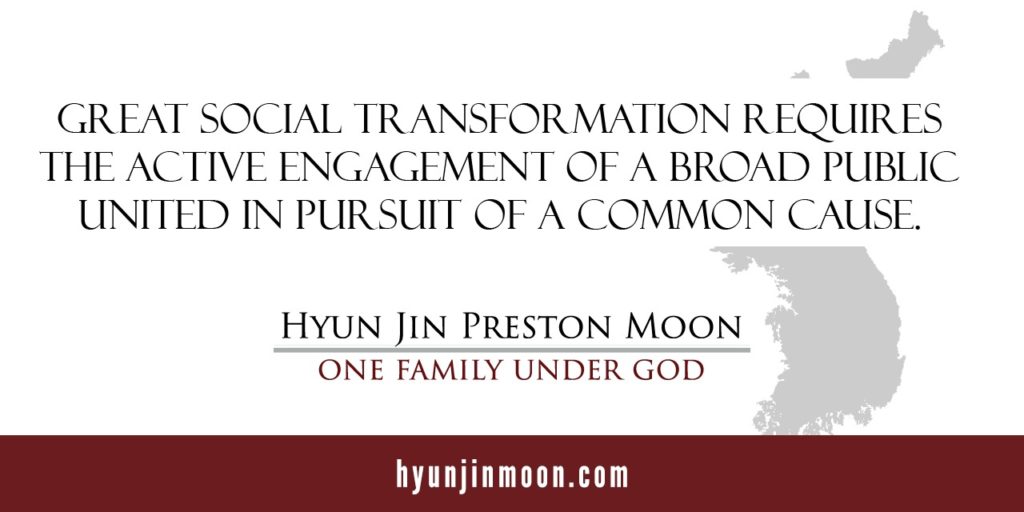
The movement launched that day on March 1st has become known as the Sam-il Movement, and next year we will commemorate its centenary. This is significant in the history of the Korean people since the founders of both South and North Korea were all part of this Independence movement. Outside of Korea, it inspired a global movement for national self-determination throughout the 20th century.
Ladies and gentlemen:
Great social transformation requires the active engagement of a broad public united in pursuit of a common cause. That cause should be unification and is not the work of governments alone. Koreans from the North, South as well as the diaspora must engage with one another on many different levels. Civic organizations and NGOs are the perfect means for such engagement. Understanding the need for a broad civil society coalition, I have been instrumental in launching and developing Action for Korea United.
Since its launch with key partners in 2012, it has grown rapidly into the largest citizen-driven movement for unification, and now includes nearly 1,000 organizations. It is making unprecedented progress in building civic consensus, bridging political, religious, and regional divides, and collaborating with government and other stakeholders to promote the cause of unification among Koreans everywhere.
AKU organizes grassroots community education programs based on the Korean Dream approach in provinces throughout Korea. These are coupled with activities through which participants, including refugees and defectors from the North, experience making unification a part of their everyday life. AKU is also building broad support and enthusiasm for unification through culture and the arts, most notably with new unification songs and One K Concerts featuring award-wining artists and top K-Pop groups, with significant reach and impact through social media.
In addition to these vital efforts, AKU has joined with the Global Peace Foundation and other partners in the One Korea Global Campaign to advance the unification agenda with a wider global public. From experts’ forums like this one, to youth exchanges, cultural initiatives and social media, the One Korea Global Campaign is building awareness and generating support for the unified Korea on virtually every continent. Many of you are already actively engaged in this One Korea Global Campaign, and I invite all of you to join us in this vital cause.
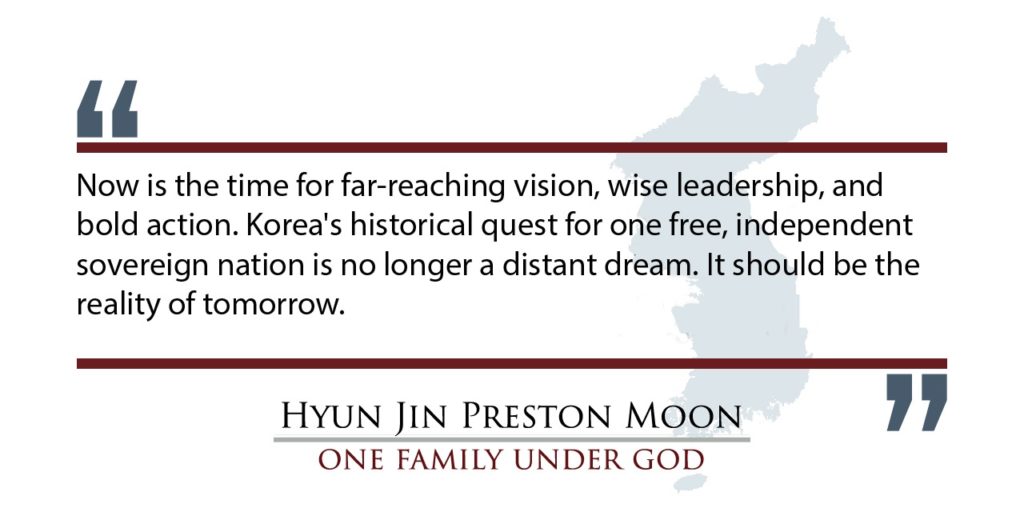
Ladies and Gentlemen:
Just last week, the nation and much of the world mourned the passing of former president George H.W. Bush. During his presidency, Bush 41 guided the U.S. and the world through historic changes – from the fall of the Berlin Wall and German unification, to the collapse of the Soviet Empire – with wisdom, foresight, and a steady hand.
At that time, German reunification was by no means guaranteed. The prevailing view was that reunification was a distant dream, and key leaders in Europe did not support a unified Germany. Despite these obstacles, President Bush worked behind the scenes in support of a grass-roots movement that led to unification in a way that established a major ally in Europe at peace with its neighbors and a bulwark against totalitarian aggression. Significantly, President Bush was able to advance German unification without alienating key Soviet leaders as they struggled to navigate major transformation in the U.S.S.R. and its empire.
There are clear lessons for Korea that can be drawn here. One is the importance of a strategic policy that has a clear end goal in mind – unification – and works towards it steadily and systematically. Another is to recognize and wisely support the popular movements that are dynamic and vital ingredients for transformation.
As I have already pointed out, there is a groundswell of support for a unified Korea that draws on the highest ideals and historic aspirations of the Korean people. This is already well underway, through a nationwide campaign we have pursued over the past eight years under the banner of Action for Korea United. Additionally, this year alone through the One Korea Global Campaign we have convened international forums in Mongolia, India, Uganda, Japan, Ireland, and across the United States, especially within the Korean American community, a number of whom are with us today.
All these efforts are to crescendo in March 1st of 2019 when Korea will have a major centennial celebration. All Koreans and the world will be reminded of the patriots that pioneered the path for national self-realization during the 20th century and planted the seeds for a new nation aligned to its founding mandate “to serve all humanity.” We hope that this event could inspire a movement for national and regional transformation that will eventually lead to unification, centered on the Korean Dream.
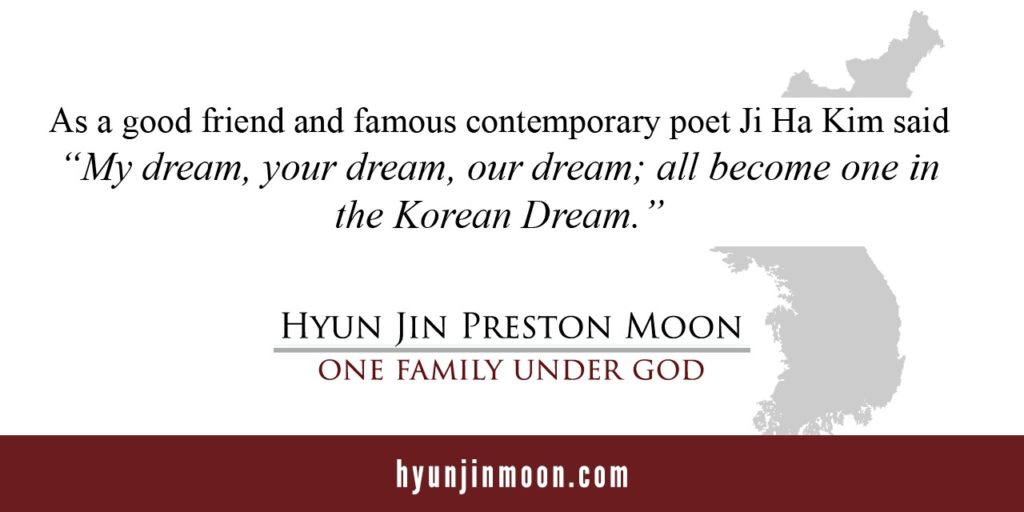 I urge the ROK, US and other nations to recalibrate their approaches. I believe that the US should widen its Korea focus, including denuclearization in the larger context of a unified Korea. A unified Korea should become the clearly stated and actively pursued policy of the U.S. and ROK with the support of the community of nations. That would not mean unification on any terms and certainly not on Pyongyang’s terms. It would look to the aspirations of Korea’s independence movement and finally realize them.
I urge the ROK, US and other nations to recalibrate their approaches. I believe that the US should widen its Korea focus, including denuclearization in the larger context of a unified Korea. A unified Korea should become the clearly stated and actively pursued policy of the U.S. and ROK with the support of the community of nations. That would not mean unification on any terms and certainly not on Pyongyang’s terms. It would look to the aspirations of Korea’s independence movement and finally realize them.
Ladies and gentlemen:
Now is the time for far-reaching vision, wise leadership, and bold action. Korea’s historical quest for one free, independent sovereign nation is no longer a distant dream. It should be the reality of tomorrow. As a good friend and famous contemporary poet Ji Ha Kim said “My dream, your dream, our dream; all become one in Korean Dream.”
Thank you all for supporting this movement to finally achieve the peaceful outcome of unification that can unleash a broader Asian renaissance for peace and prosperity.
May God bless you and your families this holiday season, and let us realize the Korean Dream!
